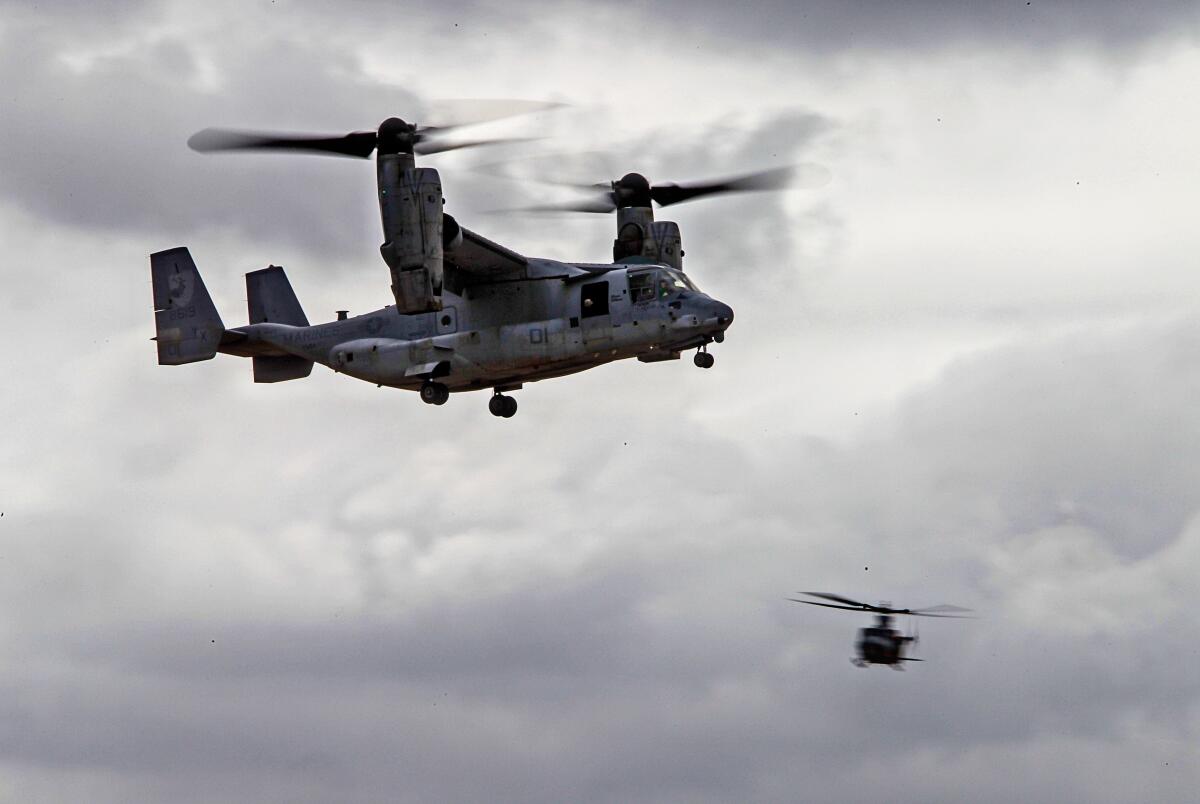U.S. sues city of San Diego over skydiving plane that slowly smashed into Marine aircraft

- Share via
SAN DIEGO — The federal government is suing over a 2020 incident in which a skydiving plane rolled and slowly crashed into a parked, unoccupied Marine Corps MV-22 Osprey aircraft at Brown Field in Otay Mesa, Calif.
The lawsuit, filed last month in San Diego federal court and first reported Tuesday by Military.com, seeks more than $5.7 million in damages, claiming the defendants owe the federal government “for the value of the repair and transportation costs.”
The suit alleges that the city of San Diego and Brown Field Municipal Airport mismanaged the facility by failing to maintain adequate parking for the Marine aircraft on the first night of a three-day training. That forced the Marine Corps flight crew to park in an unsafe location where the Osprey, a large tiltrotor aircraft, was later struck by the skydiving plane, the lawsuit alleges.
A spokesperson for the San Diego city attorney’s office, which is expected to defend the city and Brown Field, declined to comment Wednesday, citing the pending litigation.
The lawsuit also names as defendants Washington skydiving company Kapowsin Air Sports as the owner of the plane and Tac Air Ops, a limited liability company that does business as Skydive San Diego, as the operator. A representative from Kapowsin declined to comment, while representatives from Tac Air Ops and Skydive San Diego did not respond to requests for comment Wednesday.
According to the lawsuit, the crash occurred around 9:40 a.m. on May 30, 2020. The night before, a flight crew had piloted the Osprey from Marine Corps Air Station Miramar to Brown Field as part of a routine training.
But when the flight crew landed at Brown Field and taxied toward what was supposed to be its designated parking location, the crew “discovered that the airport failed to maintain adequate parking” at that location, according to the lawsuit. The crew located an alternative area to park the plane.
Unbeknownst to the crew, the alternative parking spot they chose presented hazards that were not present at the other spot, including “increased congestion associated with neighboring aircraft traffic and parking,” the lawsuit said.
The crew left the Osprey near two other planes, including a twin-engine skydiving plane, a de Havilland Canada DHC-6 Twin Otter, that had just spent two weeks under maintenance, according to the lawsuit and a city of San Diego “unusual incident report” published by U.S. Naval Institute News.
When the pilot, who is also a named defendant, started the engines on the twin-engine skydiving plane, it began rolling toward the Osprey, according to the lawsuit, which alleges that the pilot unsuccessfully tried to stop the plane.
The Twin Otter crashed into the Osprey, sparking a fire that nearby witnesses helped extinguish. U.S. Naval Institute News published photos of the crash, showing the Osprey sustained significant damage to its left wing, engine and propeller blade.
The lawsuit alleges the skydiving plane “was not in good working condition at the time of the incident.” According to the suit, the pilot told the Federal Aviation Administration that the Twin Otter’s brakes and steering were unresponsive when it crashed into the Osprey.
More to Read
Sign up for Essential California
The most important California stories and recommendations in your inbox every morning.
You may occasionally receive promotional content from the Los Angeles Times.











